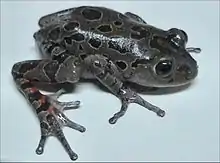Kassina
Kassina is a genus of hyperoliid frogs, commonly referred to as running frogs or kassinas. They are found throughout sub-Saharan Africa.[1] They are characterized by preferring a distinctive "walking" with the back legs instead of the more traditional frog-hopping.[2]
| Kassina | |
|---|---|
 | |
| red-legged running frog Kassina maculata | |
| Scientific classification | |
| Kingdom: | Animalia |
| Phylum: | Chordata |
| Class: | Amphibia |
| Order: | Anura |
| Family: | Hyperoliidae |
| Genus: | Kassina Girard, 1853 |
| Synonyms | |
|
Eremiophilus Fitzinger, 1843 (suppressed name) | |
Species
The following species are recognized in the genus Kassina:[1][3]
- Kassina arboricola Perret, 1985 — Ivory Coast running frog
- Kassina cassinoides (Boulenger, 1903) — silver running frog
- Kassina cochranae (Loveridge, 1941) — Cochran's running frog
- Kassina decorata (Angel, 1940) - Decorated running frog
- Kassina fusca Schiøtz, 1967 — brown running frog
- Kassina jozani Msuya, Howell, and Channing, 2007
- Kassina kuvangensis (Monard, 1937) — Kuvangu running frog
- Kassina lamottei Schiøtz, 1967 — rainforest running frog
- Kassina maculifer (Ahl, 1924) — Parker's running frog
- Kassina maculosa (Sternfeld, 1917) — marbled running frog
- Kassina mertensi Laurent, 1952 — Mertens' running frog
- Kassina schioetzi Rödel, Grafe, Rudolf, and Ernst, 2002 — Schiøtz's running frog
- Kassina senegalensis (Duméril and Bibron, 1841) — Senegal running frog
- Kassina somalica Scortecci, 1932 — Somalian running frog
- Kassina wazae Amiet, 2007
In captivity
K. maculata is frequently exported from Tanzania for the exotic pet trade. They require more horizontal space than vertical, being a terrestrial species. Their captive environment should include a substrate that accommodates burrowing, and provides high humidity. K. maculata will readily eat crickets and small mealworms,[4] although insects should be dusted with a vitamin supplement.[5]
Other species of running frogs are occasionally imported, with the K. senegalensis being the next most common species in captivity.[6]
Research
It is the source of "kassinin", a frequently studied tachykinin peptide.[7]
References
- Frost, Darrel R. (2016). "Kassina Girard, 1853". Amphibian Species of the World: an Online Reference. Version 6.0. American Museum of Natural History. Retrieved 25 April 2016.
- Ahn, A. N.; E. Furrow; A. A. Biewener (2004). "Walking and running in the red-legged running frog, Kassina maculata". Journal of Experimental Biology. 207 (3): 399–410. doi:10.1242/jeb.00761. PMID 14691087.
- "Hyperoliidae". AmphibiaWeb: Information on amphibian biology and conservation. [web application]. Berkeley, California: AmphibiaWeb. 2016. Retrieved 25 April 2016.
- "Red-Legged Walking Frog Kassina maculata". ReptileApartment.com. 2018-08-30.
- "Understanding Dusting and Gut-loading, why it may be necessary, it's risks and pitfalls - Timberline". timberlinefresh.com. Retrieved 2018-08-30.
- "Kassina sp. - breeding". Frog Forum. Retrieved 2018-08-30.
- Perfumi M, de Caro G, Panocka I, Polidori C, Massi M (1988). "Effects of kassinin, a tachykinin of the skin of the African frog Kassina senegalensis, on body fluid homeostasis in rats". Pharmacological Research Communications. 20. Suppl 5: 67–70. doi:10.1016/S0031-6989(88)80843-9. PMID 3247356.CS1 maint: uses authors parameter (link)
External links
- Grace R, Lynn A, Cowsik S (2001). "Lipid induced conformation of the tachykinin peptide Kassinin". Journal of Biomolecular Structure and Dynamics. 18 (4): 611–21, 623–5. doi:10.1080/07391102.2001.10506693. PMID 11245256.CS1 maint: uses authors parameter (link)
- Kassinin at the US National Library of Medicine Medical Subject Headings (MeSH)
